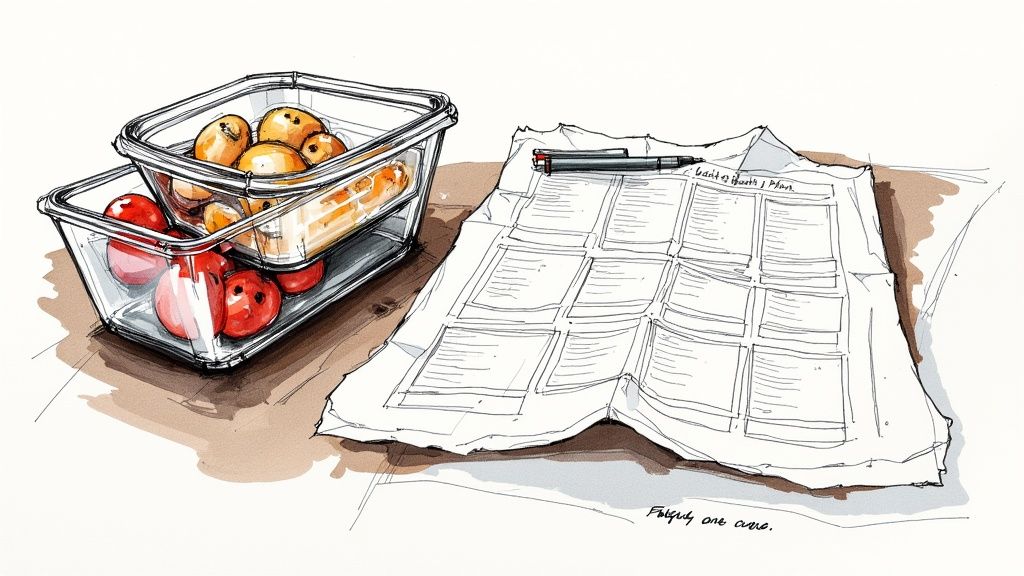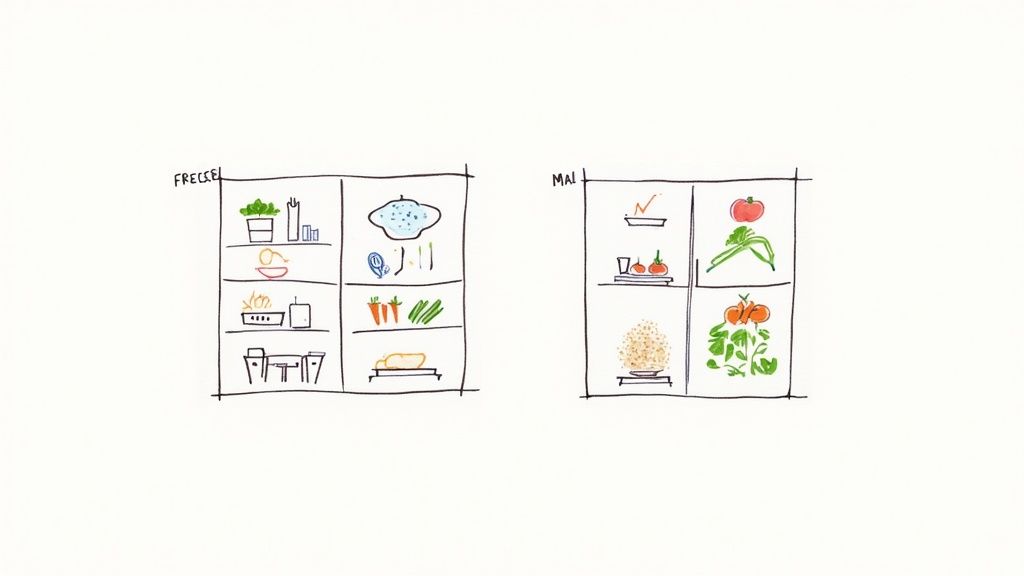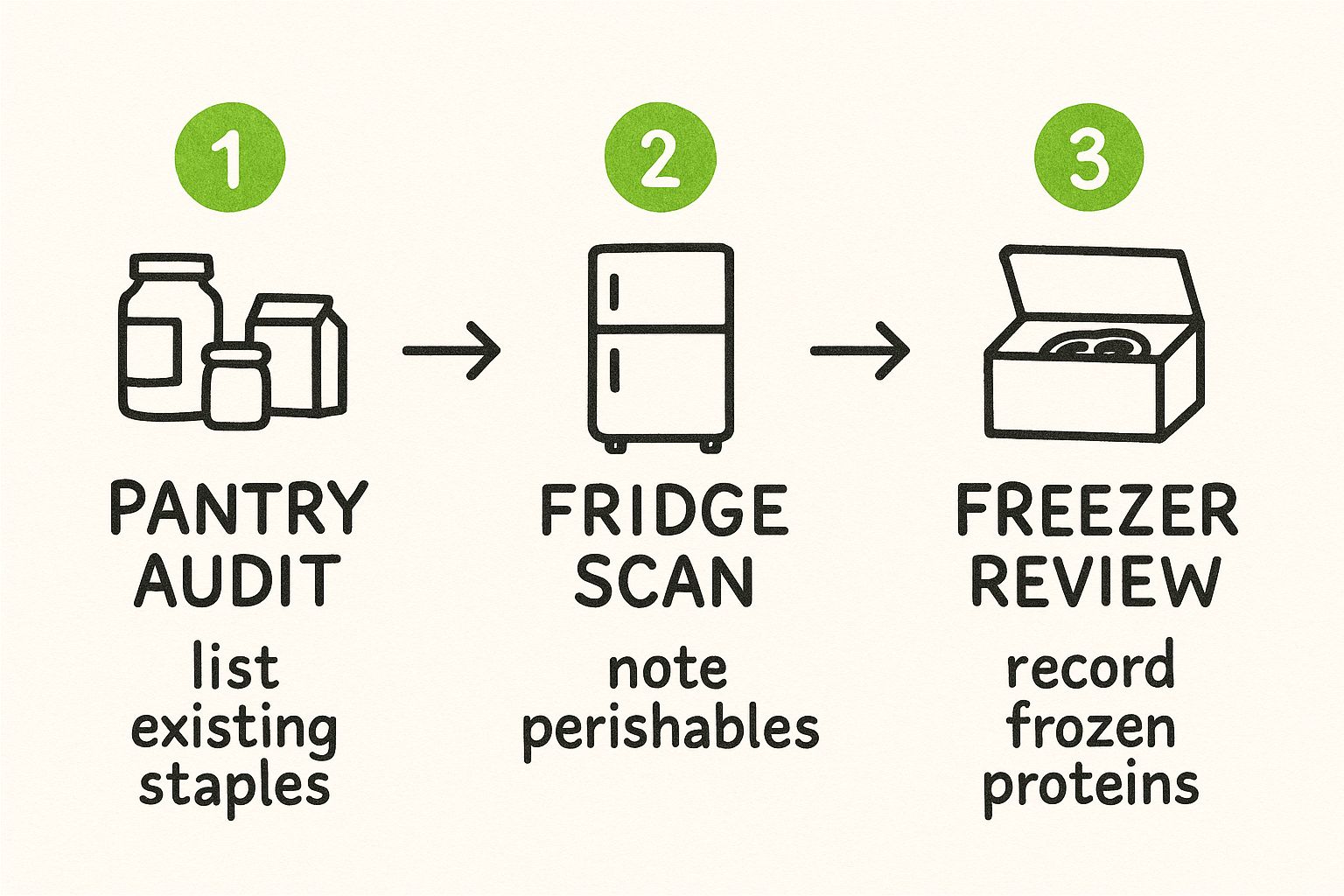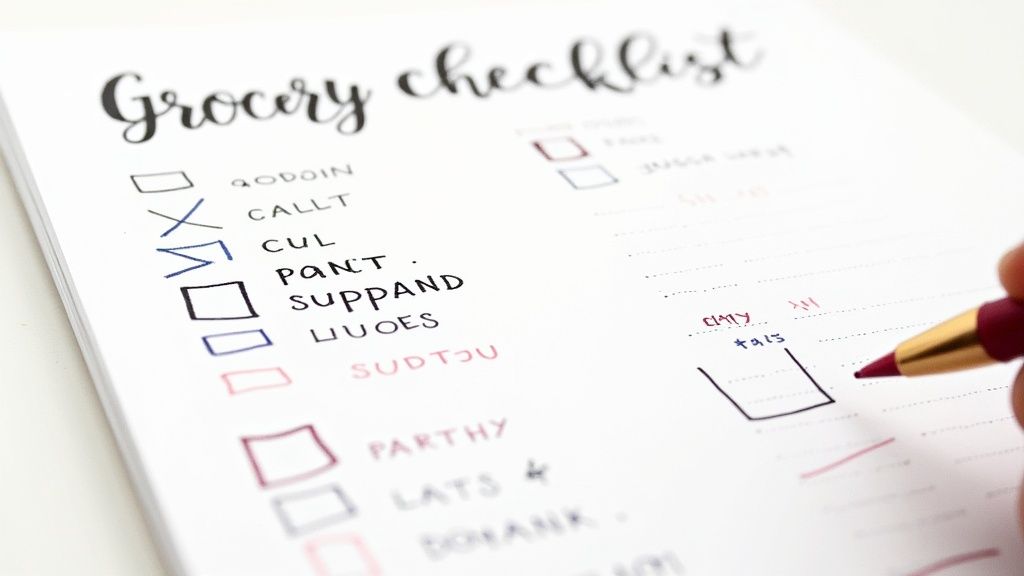Let’s be real for a second. Planning your weekly meals isn't about becoming a gourmet chef overnight. It's about building a simple, flexible system that cuts through the weeknight chaos. It all starts with a quick look at what you already have, picking a few go-to meals, and then making a shopping list that actually makes sense.
That small change transforms a dreaded chore into your secret weapon for saving time, money, and your sanity.
The Real Reason Your Meal Plan Fails

If you've ever felt the sting of meal-planning failure, you know the routine. You spend hours on Sunday mapping out five ambitious, Pinterest-perfect meals. By Thursday, you're staring at sad, forgotten containers in the back of the fridge and ordering a pizza. Sound familiar? You are definitely not alone.
The issue was never your effort. It’s the rigid, all-or-nothing mindset we're taught to adopt. We shoot for an immaculate, flawless schedule instead of building a realistic system that can survive a hectic Tuesday night. The minute an unexpected meeting pops up or soccer practice runs late, the whole rigid plan falls apart. Burnout sets in, and takeout wins again.
Shifting from Perfection to Practicality
The goal isn't to chain yourself to an unbreakable schedule. It's to build a supportive framework that makes your life easier. A good meal plan should take things off your plate, not add more to it. So, let’s ditch the pressure to cook elaborate dinners every single night.
Instead, let's focus on a simpler, more flexible approach that gives you back your time and energy. This is about:
- Reducing Decision Fatigue: Think about it—making fewer "what's for dinner?" choices during a crazy week frees up mental space for things that actually matter.
- Cutting Down on Food Waste: You’ll start by planning around the ingredients you already own, which means using things up before they go bad.
- Saving Money: A clear plan creates a laser-focused grocery list. That means fewer impulse buys and less money spent on last-minute, overpriced meals.
The most effective meal plan is a tool that serves you, not a strict set of rules that you serve. It's about creating a structure that bends with your real life, preventing weeknight chaos without demanding perfection.
At the end of the day, learning how to plan weekly meals is about building a habit that sticks. It’s a skill that grows with you, whether you're feeding a family of five on a budget or you're a busy professional just trying to eat a little healthier. Once you let go of the "perfect" plan, you can finally build one that actually works.
Your Kitchen Inventory Is Your Secret Weapon

Before you even think about opening a cookbook or scrolling through recipe blogs, your most powerful tool is sitting right in your own kitchen. Seriously. A quick "kitchen audit" of what you already have in the pantry, fridge, and freezer is the single best way to cut down your grocery bill and stop food from going to waste.
This doesn't have to be some overwhelming task that ends with a color-coded spreadsheet. It's just a simple scan to see what you're working with. Think of it like a treasure hunt where you’re guaranteed to find ways to save time and money. This habit completely changes your approach to meal planning because it starts with what's real—what you actually have on hand.
Conduct a Quick Three-Zone Scan
To make this feel less like a chore, break your kitchen down into three zones. It’s a fast process that only takes a few minutes once you get used to it. The goal is to spot the core ingredients that can anchor your meals for the week.
- The Pantry: Start with your dry goods. What’s hiding in there? That half-used bag of quinoa, the can of black beans shoved in the back, or the box of pasta you totally forgot about. These are your reliable meal starters.
- The Refrigerator: This is where things are a bit more time-sensitive. Look for produce that’s on its last legs—that bell pepper that's getting a little soft or the last handful of spinach. Don't forget to check for leftover sauces, cheese, or milk.
- The Freezer: Now for the long-haul items. Peek in and see what proteins you have, like frozen chicken breasts, ground beef, or fish fillets. Frozen veggies and fruit are gold mines for rounding out a meal in a pinch.
By starting with what you own, you shift from a mindset of "what do I need to buy?" to "what can I create?" This simple change is key to building a sustainable meal-planning habit.
Connecting the Dots into Meal Ideas
Okay, now for the fun part: start playing matchmaker with your ingredients.
That lone bell pepper from the fridge, the frozen chicken from the freezer, and the bag of rice from the pantry aren't just separate items. Together, they’re the beginning of a fantastic stir-fry. All you need is a little soy sauce and garlic, and dinner is practically done.
Spotted a can of tomatoes and some ground beef? You're halfway to a hearty pasta sauce or a batch of chili. This "reverse meal planning" method stops you from buying things you already have and pushes you to get creative. If you get stuck, you can even use tools that let you cook with ingredients you already have to spark some fresh ideas.
Learning to plan your weekly meals always starts here, not at the grocery store. Make this kitchen inventory your non-negotiable first step, and you'll find every plan you create is smarter, cheaper, and perfectly tailored to your real life.
Build a Flexible Weekly Meal Roster
Feeling like you need to find seven brand-new, exciting recipes every single week? That’s a fast track to burnout. A meal plan that actually sticks isn't about constant novelty; it’s about building a realistic, flexible roster of meals you can always fall back on. Think of it as creating a "greatest hits" collection for your kitchen—one that balances speed, comfort, and the occasional adventure.
The whole point is to stop reinventing the wheel. Instead, you create a smart mix of meals that fits the real rhythm of your life. This means looking at your actual schedule and planning dinners accordingly, because the meal you can pull off on a lazy Sunday is a world away from what’s possible on a chaotic Tuesday night.
Curate Your Go-To Meal Categories
A truly useful meal roster has three distinct categories. By having a few options in each bucket, you’re ready for whatever the week throws at you.
- 15-Minute Emergency Meals: These are your absolute lifesavers. I'm talking scrambled eggs and toast, quesadillas with canned black beans, or a simple pasta with jarred sauce. The goal here isn't culinary genius—it's getting a decent meal on the table fast when you're wiped out.
- Reliable Family Favorites: These are the tried-and-true dinners everyone actually enjoys. Maybe it's spaghetti and meatballs, chicken stir-fry, or taco night. You know the recipe by heart, and it’s always a winner. Aim to schedule three to four of these each week.
- One New Recipe (Optional): To keep things from getting boring, try adding just one new meal a week. This is your chance to experiment without the pressure of your entire week depending on untested recipes. If it’s a hit, you can promote it to your "family favorites" list.
This infographic breaks down a simple way to take stock of your kitchen before you even start building out your meal roster.

Starting with what you already have—from pantry staples to proteins in the freezer—is a game-changer for planning meals that are both practical and budget-friendly.
Let Technology Do the Heavy Lifting
Trying to find recipes that fit your specific dietary needs or time constraints can feel like searching for a needle in a haystack. This is where a little tech can make a big difference. The use of diet and nutrition apps has exploded, with global users jumping by 27% from 2019 to 2023. People now spend an average of 12 minutes a day on these platforms, which shows just how much we're turning to digital tools to get our meals organized.
A great weekly meal roster feels less like a rigid script and more like a flexible playlist. You have your upbeat hits for busy nights, your classic favorites for comfort, and a new track to keep things interesting.
Juggling this mix of emergency meals, family favorites, and new experiments is so much easier with a central hub. Instead of having recipes scattered across browser bookmarks, screenshots, and scribbled notes, using a digital recipe organizer keeps everything in one tidy spot. It makes planning faster and ensures you can always find that perfect go-to meal right when you need it.
Create a Shopping List That Actually Saves Money

A great meal roster is only half the battle. The real magic happens when you turn that plan into a smart, strategic shopping list. This isn't just about jotting down what you need; it's about building a tool that gets you through the store efficiently, saves you from impulse buys, and keeps your grocery budget in check.
Think of your shopping list as the bridge connecting your meal plan to your kitchen. A focused list turns a chaotic grocery run into a quick, targeted mission. Without one, it’s all too easy to wander the aisles, grabbing things that look good but don't actually fit your plan, leading straight to food waste and a lighter wallet.
Organize Your List for Store Navigation
One of the best tricks I've learned for a faster shopping trip is to organize my list by the store's layout. Instead of a random jumble of items, I group everything into categories that match the aisles. This simple habit stops me from backtracking and cuts down on the temptation to grab snacks on my third trip past the dairy section.
Your categories might look something like this:
- Produce: Onions, garlic, lettuce, apples
- Protein: Chicken breasts, ground beef, tofu, eggs
- Dairy: Milk, yogurt, cheese, butter
- Pantry/Dry Goods: Pasta, rice, canned tomatoes, spices, bread
- Frozen: Frozen peas, berries, or any specific frozen items needed
This method turns your list from a simple reminder into a practical map. It keeps you focused on your plan and gets you out of the store faster, which is always a win in my book.
The most overlooked step in meal planning is the final pantry check. Taking sixty seconds to scan your fridge and cupboards before you walk out the door is the easiest way to avoid buying a third jar of mustard you don't need.
From Recipe to Reality
When you’re building out your list, get specific with quantities to avoid overbuying. If a recipe calls for 500g of ground beef, write that down. If you're not sure about converting measurements from a recipe, a good cups-to-grams converter can be a lifesaver for accuracy, ensuring you buy just the right amount.
Also, do one final cross-reference between your list and your kitchen inventory. It’s so easy to forget you already have half a bag of onions or plenty of olive oil. This last check is crucial for anyone trying to figure out how to plan weekly meals on a budget. It's the simple discipline that separates a thoughtful planner from an accidental over-spender.
Ultimately, your shopping list is more than just a piece of paper—it’s the blueprint for a successful, stress-free week of delicious meals.
How to Make Your Meal Plan Stick
Alright, you’ve done the hard work. You audited your kitchen and even put together a solid list of go-to meals. But now comes the real test: making your plan survive contact with real life.
The best meal plan isn't the most ambitious one. It’s the one that can handle a little chaos without completely falling apart. This is where the real magic happens—not in following a rigid schedule, but in building a smart, flexible system. A plan that shatters the moment a friend invites you out for a spontaneous dinner isn't a plan; it's a cage. The goal is to create a structure that actually serves you.
Embrace the Built-In Break
One of the best things I ever did for my meal plan was to schedule flexibility right into the week. I call it a "flex night." It's one designated evening where there's no set plan, giving you permission to be human.
Here’s how you can use a flex night:
- Leftover Night: This is the perfect chance to clean out the fridge and make sure nothing goes to waste.
- Takeout Night: Planning for one takeout meal removes the guilt. It becomes a conscious choice, not a moment of failure.
- Spontaneous Dinner Out: If an opportunity comes up, you can take it without feeling like you've derailed your entire week.
This simple buffer is a game-changer. It acknowledges that life is unpredictable and gives your meal plan the resilience it needs to bend without breaking.
Prioritize Your Planning Energy
It's tempting to try and plan every single meal and snack, but trust me, that’s a quick path to burnout. The key is to focus your energy where it matters most: dinner.
For most of us, breakfast and lunch are pretty repetitive anyway. You probably rotate through the same few options—cereal, yogurt, salads, or sandwiches. Dinner is where the most variability, and stress, usually creeps in. Research backs this up, showing that most people who meal plan focus their efforts on the evening meal. In fact, about 70% of them stick to their plans closely, which shows just how effective this focused approach can be. You can find more details about these consumer habits and see how US households approach meal planning.
Your meal plan should be a tool that reduces decision fatigue, not one that adds to it. By keeping breakfast and lunch simple and focusing on dinner, you get the biggest return on your planning investment.
Use Tools That Simplify Your System
A scattered system is a fragile one. Juggling recipes saved on Instagram, scribbled on notepads, and buried in browser bookmarks just adds unnecessary friction. To make your plan stick, you need to centralize everything.
If you need a hand getting your recipe collection under control, our guide on the top recipe apps can point you toward some great tools designed to keep everything organized in one place.
Ultimately, making a meal plan work is less about willpower and more about smart design. By building in flexibility, focusing on the meals that cause the most stress, and using the right tools, you create a system that truly supports you, even through the busiest of weeks.
Frequently Asked Questions About Meal Planning
Even the most organized person hits a few snags when they first start planning weekly meals. It’s a personal process, and figuring out what truly works for you often means troubleshooting a few common hurdles.
Here are some straightforward answers to the challenges I hear about most often. Think of these as a starting point to help you build a system that fits your life, not the other way around.
How Do I Meal Plan on a Tight Budget?
The trick is to build your meals around inexpensive, filling pantry staples. Think beans, rice, pasta, and oats. Before you even think about recipes, grab your local grocery store's weekly flyer. See what protein or produce is on sale and plan at least one or two meals around those deals.
Cooking in larger batches is also a huge money-saver. A big pot of chili, lentil soup, or a simple casserole can cover several meals for a much lower cost per serving. And don't forget to sprinkle in a couple of plant-based meals each week—they’re almost always cheaper than meat-based dinners.
What Is the Best Way to Handle Leftovers?
Don't let leftovers be an afterthought. The key is to plan for them.
My favorite trick is to designate one night a week as a "leftover buffet." Everyone gets to pick their favorite from the past few days, which clears out the fridge and gives you a night off from cooking. Win-win.
You can also get creative and transform them. That leftover roasted chicken? It’s perfect for chicken salad sandwiches, quick tacos, or the base of a new soup. To make sure they don’t get lost in the back of the fridge, always store leftovers in clear, labeled containers right at the front.
A smart leftover strategy is one of the best ways to stretch your food budget and cut down your kitchen time. It’s not about eating the same thing twice; it’s about making your initial effort work harder for you.
How Can I Keep My Meal Plan From Getting Boring?
To keep things interesting without getting overwhelmed, try adding just one new recipe each week. It’s a small change that adds a ton of variety. If it’s a hit, you’ve got a new favorite for your rotation. Of course, a good system for tracking new finds and old favorites is a must. You can learn more about how to categorize recipes effectively to build a library you'll actually use.
Another great idea is to use theme nights—like "Taco Tuesday" or "Pasta Friday"—but switch up the specific recipe within that theme. Sometimes all it takes is a new spice blend or a different sauce to make a familiar dish feel brand new. The demand for personalized solutions like this is why the meal planner market is booming, with projections showing it could surge to USD 38.71 billion by 2035. You can see more details in this meal planner market analysis.
What If I Do Not Have Time for a Big Prep Day?
Good news: you don't need one! Instead of a massive, hours-long prep session, embrace what I call "micro-prepping."
This just means taking small, manageable steps throughout the week that save you time later.
- While you’re already in the kitchen making dinner, go ahead and chop the extra onions and peppers you'll need for tomorrow night.
- Got a spare 15 minutes after putting away groceries? Use it to wash and dry lettuce or portion out snacks into grab-and-go bags.
These tiny pockets of productivity really add up and can make a huge difference during a busy week.

